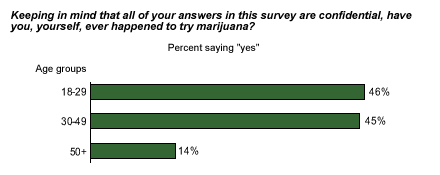Off the top of your head, who would you say is more likely to have ever smoked marijuana, a Republican or a Democrat? A Californian or a New Yorker? Suburbanites or urban dwellers? The results of a 1999 Gallup poll* asking people if they have ever tried marijuana have the answers, and they may astonish you.
The Young and the Reckless
A third of Americans (34%) said they had tried marijuana at some point. Men were more likely than women to have tried it, 43% to 27%. One might expect to find generational differences, but the proportion of 18- to -29-year-olds and the proportion of 30- to -49-year-olds who say they have tried it are about the same -- 46% and 45%, respectively. However, the figure plummets to 14% among those aged 50 and older.


An Urban Problem?
Many people view drugs as a city problem. In fact, there's very little difference in drug experimentation by population center. Thirty-eight percent of urban dwellers have tried marijuana, as have 31% of suburbanites, and 34% of people who live in rural areas. Easterners are about as likely as Southerners and Westerners to have tried marijuana (35%, 34% and 38%, respectively), but somewhat more likely than Midwesterners (29%). And marijuana is not a "minority" drug. Thirty-five percent of whites say they have tried it. That number drops to 25% among non-whites.
Marijuana Politically
As Republicans are much less likely than Democrats to think marijuana use should be legal (21% versus 36%), it stands to reason that Republicans would be less likely to have tried marijuana. According to the poll, about the same percentage of Republicans (33%) and Democrats (31%) have experimented with the drug. The numbers are more in line with expectations when categorized by ideology. Conservatives are much less likely (27%) to have tried marijuana than are liberals (46%) or moderates (36%).
*Results based on a telephone interviews with 1,000 national adults, aged 18 and older, conducted Sept. 23-26, 1999. For results based on the total sample of national adults, one can say with 95% confidence that the maximum margin of sampling error is ±3%.
